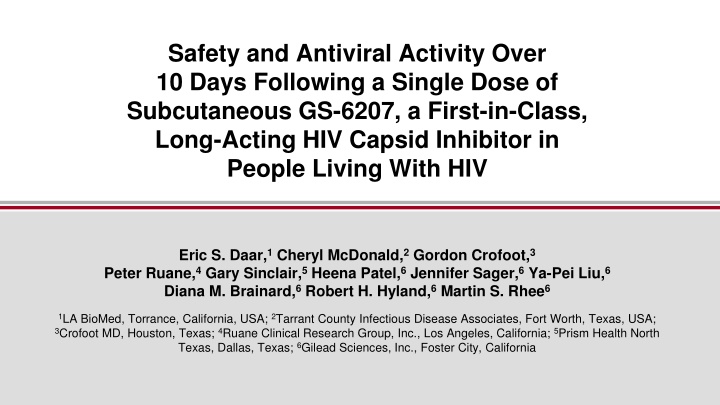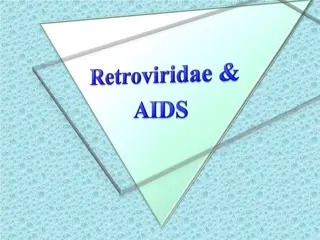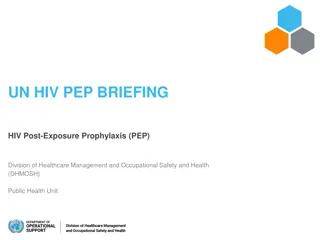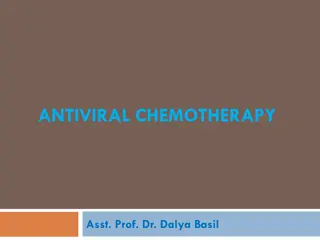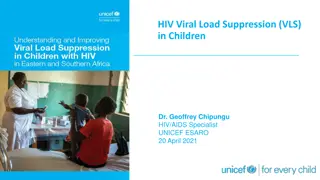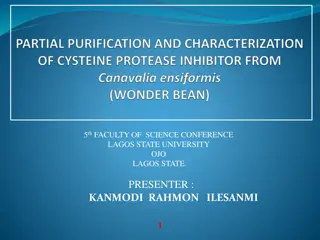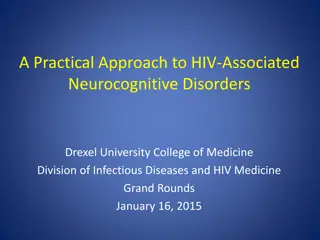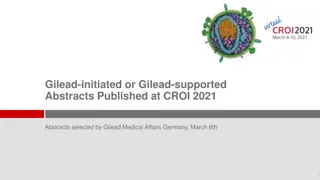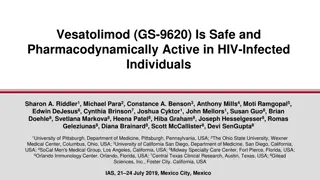Safety and Antiviral Activity of GS-6207: A First-in-Class HIV Capsid Inhibitor
GS-6207 is a novel long-acting HIV capsid inhibitor with promising antiviral activity and safety profile in people living with HIV. The study evaluates the efficacy of a single subcutaneous dose of GS-6207 in reducing plasma HIV-1 RNA levels over 10 days. Results show potential benefits for heavily treatment-experienced individuals, indicating a new treatment option with a unique resistance profile. The trial also assesses the safety and tolerability of GS-6207 in participants, with encouraging outcomes observed. This first-in-class capsid inhibitor holds significant potential in addressing unmet medical needs for effective antiretroviral therapy in HIV patients.
Download Presentation

Please find below an Image/Link to download the presentation.
The content on the website is provided AS IS for your information and personal use only. It may not be sold, licensed, or shared on other websites without obtaining consent from the author.If you encounter any issues during the download, it is possible that the publisher has removed the file from their server.
You are allowed to download the files provided on this website for personal or commercial use, subject to the condition that they are used lawfully. All files are the property of their respective owners.
The content on the website is provided AS IS for your information and personal use only. It may not be sold, licensed, or shared on other websites without obtaining consent from the author.
E N D
Presentation Transcript
Safety and Antiviral Activity Over 10 Days Following a Single Dose of Subcutaneous GS-6207, a First-in-Class, Long-Acting HIV Capsid Inhibitor in People Living With HIV Eric S. Daar,1Cheryl McDonald,2Gordon Crofoot,3 Peter Ruane,4Gary Sinclair,5Heena Patel,6Jennifer Sager,6Ya-Pei Liu,6 Diana M. Brainard,6Robert H. Hyland,6Martin S. Rhee6 1LA BioMed, Torrance, California, USA; 2Tarrant County Infectious Disease Associates, Fort Worth, Texas, USA; 3Crofoot MD, Houston, Texas; 4Ruane Clinical Research Group, Inc., Los Angeles, California; 5Prism Health North Texas, Dallas, Texas; 6Gilead Sciences, Inc., Foster City, California
Introduction GS-6207 is a novel, first-in-class, multistage, selective inhibitor of HIV-1 capsid (CA) function GS-6207 can meet significant unmet medical needs for: Antiretrovirals (ARVs) with a novel mechanism of action Heavily treatment-experienced people living with HIV ARVs that require less frequent dosing (ie, long-acting ARVs) In an in vitro study, GS-6207 showed a unique resistance profile that does not overlap with any existing ARVs1 In a previous clinical study in HIV-negative healthy participants, single subcutaneous (SC) doses of GS-6207 up to 450 mg were well tolerated and maintained systemic exposure for over 24 weeks2 We now report the antiviral activity and safety of SC GS-6207 in people living with HIV Safety data are currently blinded and are reported by cohort 1. Yant SR, et al. CROI 2019, poster 480; 2. Sager JE, et al. CROI 2019, oral O-13. 2
GS-6207: First-in-Class HIV Capsid Inhibitor CA Assembly CA Reverse transcriptase) Integrase Virus Gag/Gag-Pol (CA precursors) Production CA Disassembly and Nuclear Transport HIV RNA HIV DNA GS-6207 (EC50: 50 pM) 3 EC50, half-maximal effective concentration.
Objectives Primary: to assess the efficacy of GS-6207 in reducing plasma HIV-1 RNA over 10 days after a single dose Secondary: to assess the safety and tolerability of GS-6207 4
Study Design n=6 GS-6207 50 mg B/F/TAF n=6 Key inclusion criteria: GS-6207 150 mg B/F/TAF 3:1 HIV-1 RNA 5000 400,000 copies/mL n=6 CD4+ cell count >200 cells/mm3 GS-6207 450 mg B/F/TAF Na ve to capsid and integrase inhibitors B/F/TAF n=6 Placebo B/F/TAF Day 1 Day 10 Primary Endpoint Single SC Dose Phase 1b, double-blind, randomized, placebo-controlled, dose-ranging study (ClinicalTrials.gov NCT03739866) Primary endpoint: maximum reduction of plasma HIV-1 RNA through Day 10 Secondary endpoint: safety and tolerability of GS-6207 All participants were required to start B/F/TAF on Day 10 Antiviral activity data were unblinded; safety data remain blinded given that GS-6207 was detectable for over 6 mo in HIV-negative subjects in a previous clinical study1 B, bictegravir; CD4, cluster of differentiation-4; F, emtricitabine; INSTI,integrase strand-transfer inhibitor; TAF, tenofovir alafenamide. 1. Sager JE, et al. CROI 2019, oral #13. 5
Demographics and Baseline Characteristics* GS-6207 50 mg or Placebo n=8 28 (19 56) 0 5 (63) 2 (25) 1 (13) 0 25 (21 28) 4.33 (4.2 4.7) 594 (459 662) 6 (75) GS-6207 150 mg or Placebo n=8 36 (24 56) 1 (13) 4 (50) 3 (38) 0 1 (12) 26 (20 34) 4.57 (4.3 4.6) 388 (309 581) 4 (50) GS-6207 450 mg or Placebo n=8 29 (20 59) 0 5 (63) 3 (38) 0 0 25 (23 29) 4.48 (4.4 4.6 430 (260 611) 7 (88) Total N=24 34 (19 59) 1 (4) 14 (58) 8 (33) 1 (4) 1 (4) 25 (20 34) 4.48 (4.3 4.6) 442 (340 661) 17 (71) Age, years Female White Black Asian Other Race BMI, kg/m2 HIV-1 RNA, log10 copies/mL CD4 count, cells/ L ARV treatment na ve *Data were pooled from the 6 active and 2 placebo participants in each cohort as the data are currently blinded; data are median (range) or n (%). BMI, body mass index. 6
Duration of Follow Up* GS-6207 50 mg or Placebo n=8 33 (6) 32 28, 39 25, 39 GS-6207 150 mg or Placebo n=8 90 (16) 102 72, 102 67, 102 GS-6207 450 mg or Placebo n=8 27 (11) 25 18,39 16, 39 Total N=24 50 (31) 39 28, 72 16, 102 Days Mean (SD) Median Q1, Q3 Min, Max *Data were pooled from the 6 active and 2 placebo participants in each cohort as data are currently blinded. Q, quartile; SD, standard deviation. 7
Subcutaneous GS-6207: Antiviral Activity Single SC GS-6207 dose Start of B/F/TAF 0.5 0 Mean Change in HIV-1 RNA, Log10 copies/mL (95% CI) -0.5 -1 -1.5 -2 Placebo (n=6) GS-6207 50 mg (n=6) GS-6207 150 mg (n=6) GS-6207 450 mg (n=6) -2.5 -3 1 2 3 4 5 6 7 8 9 10 Time, Day No treatment-emergent resistance was detected 8 CI, confidence interval.
Antiviral Activity Through Day 10 Maximum Reduction From Baseline, Log10 copies/mL GS-6207 50 mg n=6 GS-6207 150 mg n=6 GS-6207 450 mg n=6 Placebo n=6 Mean -1.8 -1.8 -2.2 -0.2 95% CI (-2.3, -1.3) (-2.0, -1.6) (-2.7, -1.7) (-0.4, -0.1) Median (Q1, Q3) -1.7 (-2.3, -1.6) -1.8 (-1.9, -1.6) -2.2 (-2.5, -1.8) -0.2 (-0.3, -0.1) Min, Max -2.4, -1.2 -2.1, -1.5 -2.9, -1.6 -0.4, -0.1 At doses of 50 to 450 mg, mean GS-6207 concentrations on Day 10 were 1.1- to 9.9-fold higher than the protein-adjusted, 95% effective concentration for wild-type HIV-1 9
Safety Summary: Blinded Data GS-6207 50 mg or Placebo n=8 6 (75) 0 0 GS-6207 150 mg or Placebo n=8 7 (88) 0 0 GS-6207 450 mg or Placebo n=8 6 (75) 0 0 Total N=24 Participants, n (%) Any AE Grade 3 or 4 AE Serious AE AE leading to discontinuation Death 19 (79) 0 0 AEs 0 0 0 0 0 0 0 0 Laboratory abnormalities Grade 3 or 4 0 2 (25) 0 2 (8) All AEs reported were Grade 1 or 2 in severity The most common AEs were mild-to-moderate reactions at the injection site (63%; n=15), all which were self-limiting Grade 3 or 4 laboratory abnormalities included exercised-related creatine kinase (n=1) and asymptomatic lipase (n=1) 10 AE, adverse event.
This slide was not included in final poster Keep or delete? Adverse Events in >1 Participant 50 mg GS-6207 or Placebo N=8 150 mg GS-6207 or Placebo N=8 450 mg GS-6207 or Placebo N=8 Participants, n (%) Injection-site pain 4 (50) 5 (63) 4 (50) Injection-site erythema 1 (13) 5 (63) 2 (25) Injection-site induration 1 (13) 4 (50) 2 (25) Upper respiratory tract infection 0 0 4 (50) Nasopharyngitis 0 2 (25) 0 All AEs reported were Grade 1 or 2 in severity 11
Conclusions Single SC dose of GS-6207 from 50 to 450 mg resulted in potent antiviral activity in people living with HIV Mean maximum HIV-1 RNA declines ranged from 1.8 to 2.2 log10 copies/mL over 10 days In a blinded safety review, GS-6207 and placebo were generally safe and well tolerated Most common AEs were self-limiting mild-to-moderate injection-site reactions These results support further evaluation of GS-6207 as a long-acting ARV in people living with HIV 12
Acknowledgments We extend our thanks to the participants, their families, and all participating study investigators and staff: D Asmuth, P Benson, M Berhe, G Crofoot, E Daar, C McDonald, A Mills, O Osiyemi, MN Ramgopal, E DeJesus, PJ Ruane, GI Sinclair. This study was funded by Gilead Sciences, Inc. Presented at 10th IAS Conference on HIV Science, 21 24 July 2019, Mexico City, Mexico 13
